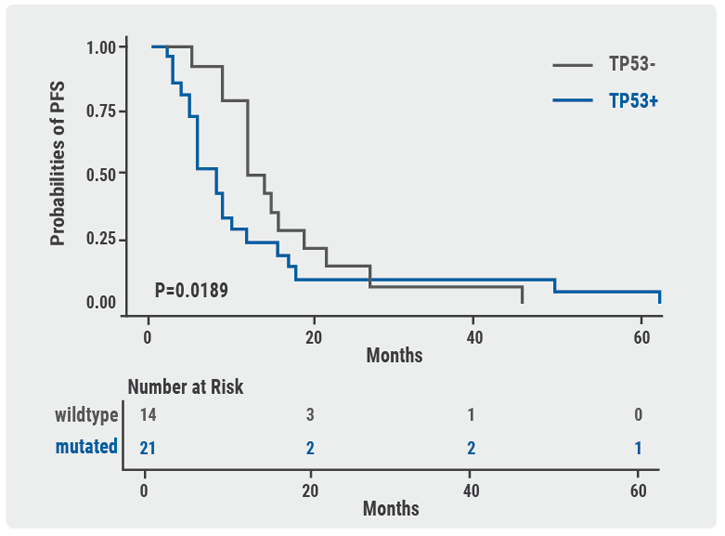In this trial, a total of 537 patients with previously untreated ES-SCLC and Eastern Cooperative Oncology Group Performance Status (ECOG PS) 0/1 were randomised (1:1:1) to durvalumab 1,500 mg + etoposide q3w; durvalumab 1,500 mg + tremelimumab 75 mg + etoposide q3w; or etoposide q3w. Patients in immunotherapy arms received up to 4 cycles of etoposide followed by maintenance durvalumab until progression. Patients in the etoposide arm received up to 6 cycles of etoposide and PCI (at the investigator’s discretion). Investigator’s choice of cisplatin or carboplatin was allowed across all arms and was a stratification factor at randomisation. The primary endpoint was OS and the data cut-off was 11 March 2019.
The results showed that 56.8% of patients received 6 cycles of etoposide. The addition of durvalumab to etoposide resulted in significantly improved OS compared to etoposide, with 33.9 of patients in the durvalumab + etoposide arm still alive at 18 months vs 24.7% in the etoposide arm [1]. Median OS was 13 months vs 10.3 months, respectively (HR 0.73; 95% CI 0.591-0.909; P=0.0047). Median progression-free survival (PFS) was 5.1 vs 5.4 months, respectively (HR 0.78; 95% CI 0.645-0.936); the 12-month PFS rate was 17.5% vs 4.7%, respectively. Mean duration of response was 5.1 months vs 5.1 and the objective response rate (ORR) was 67.9 vs 57.6, respectively (OR 1.56; 95% CI 1.095-2.218).
The incidences of grade 3/4 adverse events and adverse events leading to discontinuation were similar between arms; the incidence of haematological toxicities was numerically higher in the etoposide arm. It needs to be noted that this chemo-immunotherapy regimen offers flexibility in platinum choice (carboplatin or cisplatin), reflecting current clinical practice for this challenging disease. Thus, combining durvalumab with either cisplatin- or carboplatin-etoposide in ES-SCLC provides an important new treatment option for patients and physicians.
Editor note: This study correlates well in its outcome with IMPOWER 133 (comparing standard carboplatine/etoposide with or without additional atezolizumab), showing a significant survival benefit in the first-line treatment of metastatic SCLC patients. The fact that this is the first meaningful advance in the systemic treatment of mSCLC in this century gives these results even more importance.
- Paz-Ares L, et al. PL02.11. WCLC 2019.
Posted on
Previous Article
« Five-fold increase of OS at 5 years with nivolumab vs docetaxel Next Article
BMI and age do not influence survival/irAEs in patients treated with immune checkpoint inhibitors »
« Five-fold increase of OS at 5 years with nivolumab vs docetaxel Next Article
BMI and age do not influence survival/irAEs in patients treated with immune checkpoint inhibitors »
Table of Contents: WCLC 2019
Featured articles
Five-fold increase of OS at 5 years with nivolumab vs docetaxel
Screening, Detection, and Diagnosis
Non-Small-Cell Lung Cancer
Five-fold increase of OS at 5 years with nivolumab vs docetaxel
Promising phase 1 results of novel KRAS-inhibitor in NSCLC
Selpercatinib (LOXO-292) shows durable activity in RET fusion-positive lung cancer
Other Thoracic Malignancies
Immuno-Oncology
Nivolumab + ipilimumab safe first-line treatment for NSCLC patients with comorbidities
Targeted Therapy
Phase 3 Trial Updates
First-line pembrolizumab monotherapy offers durable OS benefit vs chemotherapy in NSCLC patients with high PD-L1 expression
Related Articles
October 29, 2020
Social smoking: Do not underestimate the risks

April 19, 2022
ELCC 2022 Highlights Podcast

© 2024 Medicom Medical Publishers. All rights reserved. Terms and Conditions | Privacy Policy
HEAD OFFICE
Laarderhoogtweg 25
1101 EB Amsterdam
The Netherlands
T: +31 85 4012 560
E: publishers@medicom-publishers.com

